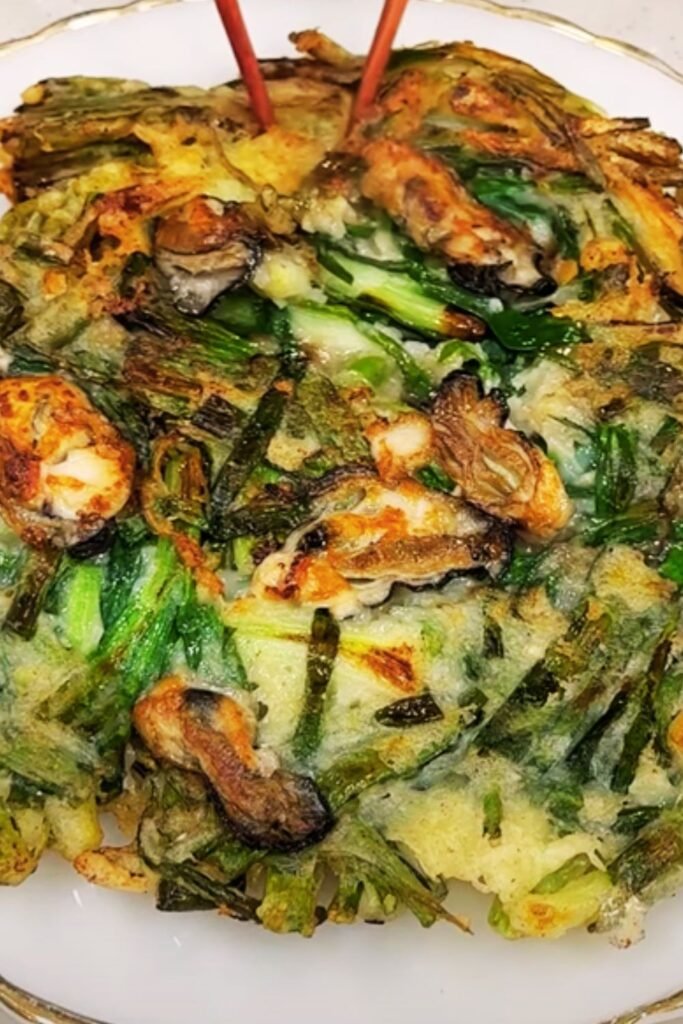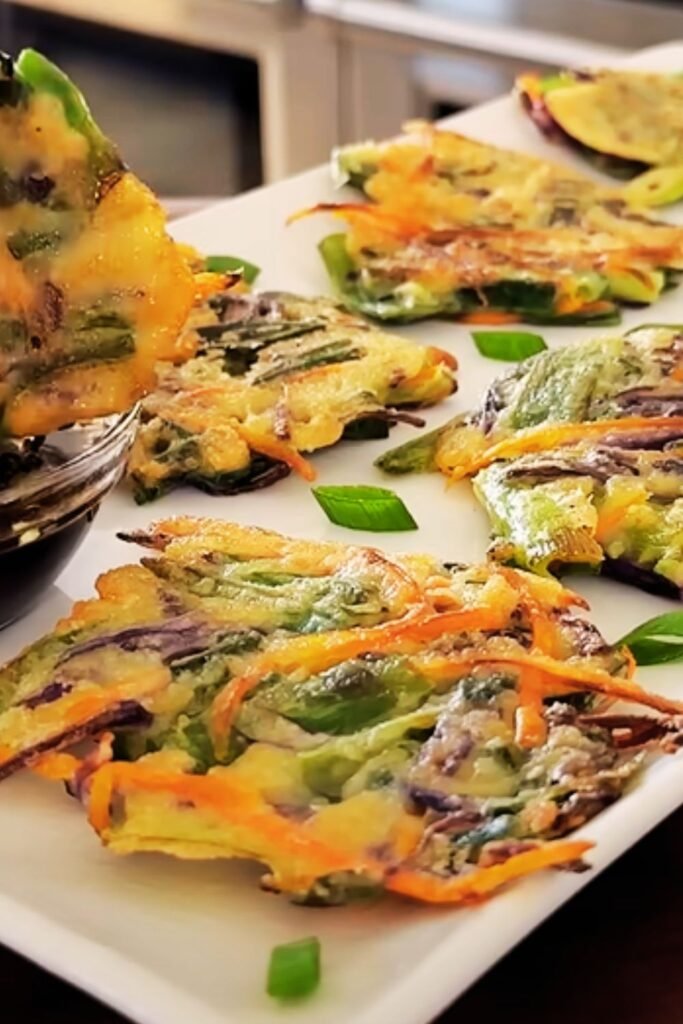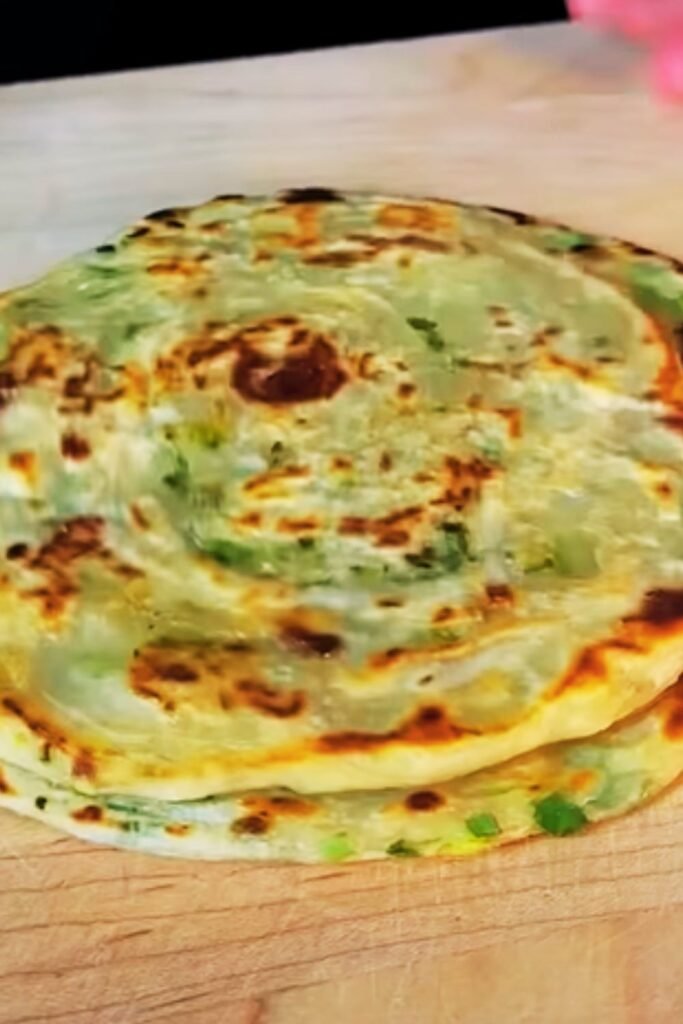When it comes to Asian street food that has captured hearts globally, few can match the simple charm of a perfectly made scallion pancake. These golden, flaky discs studded with fragrant green onions have been my comfort food since childhood, and I’m thrilled to share my perfected recipe with you today.
What Are Scallion Pancakes?
Scallion pancakes, known as “cong you bing” in Chinese, are savory flatbreads layered with sesame oil and chopped scallions. Unlike Western pancakes made from batter, these are crafted from dough, creating a pastry-like texture with distinct flaky layers. The pancakes are pan-fried until golden and crispy on the outside while maintaining a chewy interior.
The beauty of scallion pancakes lies in their contrast of textures and flavors: the crispness of the exterior, the tender chewiness within, the aromatic scallions, and that subtle nutty flavor from sesame oil. They’re truly a masterclass in simplicity becoming something extraordinary.
The History Behind This Beloved Street Food
Scallion pancakes date back over 2,000 years in Chinese cuisine. Legend has it that Marco Polo was so enamored with these flatbreads during his travels to China that he attempted to recreate them upon returning to Italy, possibly inspiring what would later become pizza.
Originally a northern Chinese staple, these pancakes have spread throughout East and Southeast Asia, each region adding its own twist. In Taiwan, they’re a popular breakfast item, while in Korea (where they’re called pajeon), they often include additional vegetables and sometimes seafood.
I’ve traveled extensively throughout Asia, sampling countless versions of these pancakes, and I’ve incorporated the best techniques from each region into the recipe I’m sharing today.
The Secret to Perfect Scallion Pancakes

After years of practice and countless batches (some more successful than others!), I’ve discovered that the secret to exceptional scallion pancakes boils down to three key elements:
- Proper dough hydration: The dough needs to be elastic but not sticky.
- The lamination technique: Creating those flaky layers requires a specific rolling and folding method.
- Temperature control: Both for resting the dough and for frying the pancakes.
The most common mistake I see people make is rushing the process. These pancakes require time for the gluten to relax between steps, which is crucial for achieving that perfect texture.
Essential Ingredients
Here’s what you’ll need to make authentic scallion pancakes:
| Ingredient | Amount | Notes |
|---|---|---|
| All-purpose flour | 2 cups (250g) | Unbleached works best |
| Boiling water | ½ cup (120ml) | For the hot water dough method |
| Cold water | ¼ cup (60ml) | Added gradually as needed |
| Salt | 1 teaspoon | Fine sea salt preferred |
| Scallions (green onions) | 1 bunch (about 8), finely chopped | About 1 cup chopped |
| Sesame oil | 3 tablespoons | Toasted variety for best flavor |
| Vegetable oil | ¼ cup + more for frying | Any neutral oil works |
| Five-spice powder (optional) | ½ teaspoon | Adds traditional complexity |
| White pepper (optional) | ¼ teaspoon | For subtle heat |
The Dipping Sauce Components
| Ingredient | Amount | Notes |
|---|---|---|
| Soy sauce | 3 tablespoons | Light or dark based on preference |
| Rice vinegar | 1 tablespoon | Adds brightness |
| Chili oil | 1 teaspoon | Adjust to taste |
| Garlic | 1 clove, minced | Fresh is essential |
| Ginger | 1 teaspoon, grated | Optional but recommended |
| Sugar | ½ teaspoon | Balances flavors |
| Scallion greens | 1 tablespoon, finely chopped | For garnish |
Step-by-Step Preparation Method
Making the Perfect Dough
- Create a hot water dough base: Place 2 cups of flour in a large bowl. Pour ½ cup boiling water over half the flour while stirring rapidly with chopsticks or a fork. This partially cooks the flour, creating that distinctive chewy texture.
- Add cold water: Gradually add cold water to the remaining flour, stirring until the mixture forms shaggy dough.
- Knead until smooth: Turn the dough onto a floured surface and knead for 5-7 minutes until smooth and elastic. The dough should bounce back slowly when poked.
- Rest the dough: Place the dough ball in an oiled bowl, cover with a damp cloth, and let rest for at least 30 minutes (or up to 2 hours). This relaxes the gluten and makes the dough more workable.
Creating the Flaky Layers

- Prepare the oil mixture: While the dough rests, mix 3 tablespoons of sesame oil with any optional spices (five-spice powder, white pepper).
- Divide the dough: Cut the rested dough into 4 equal pieces. Work with one piece at a time, keeping the others covered.
- Roll out the dough: On a lightly floured surface, roll one piece into a thin rectangle, approximately 12×8 inches.
- Apply the oil mixture: Brush a thin layer of the seasoned sesame oil over the surface, leaving a ½-inch border.
- Add scallions: Sprinkle ¼ of the chopped scallions evenly over the oiled surface.
- Create the roll: Starting from the long edge, tightly roll up the dough like a jelly roll.
- Form a spiral: Take the roll and coil it into a snail-like spiral. Tuck the end underneath and press gently to seal.
- Rest again: Let the spirals rest for 15 minutes. This prevents the pancakes from springing back when rolled out again.
- Final rolling: Gently flatten each spiral with your palm, then roll into a 7-inch disc. Don’t worry if some scallions peek through – that’s perfectly normal!
The Cooking Process
- Heat the pan: Preheat a heavy skillet (cast iron works best) over medium heat. Add 2 tablespoons of vegetable oil.
- Fry the pancake: Place one pancake in the pan and cook for 2-3 minutes until golden brown on the bottom.
- Flip and press: Turn the pancake over, drizzle 1 teaspoon of oil around the edges, and press down with a spatula to ensure even contact with the pan. This helps create those crispy layers.
- Cover briefly: Cover the pan for 30 seconds to ensure the inside cooks through.
- Finish uncovered: Remove the lid and cook for another minute until both sides are golden brown and crispy.
- Rest and slice: Transfer to a cutting board, let rest for 2 minutes, then cut into quarters.
- Repeat: Continue with the remaining pancakes, adding more oil as needed.
Troubleshooting Common Issues
| Problem | Possible Cause | Solution |
|---|---|---|
| Pancakes too doughy in center | Cooking temperature too high | Lower heat and cook longer |
| Not enough flaky layers | Dough rolled too thick initially | Roll thinner before applying oil |
| Scallions burning | Heat too high | Use medium heat and watch carefully |
| Dough springs back when rolling | Insufficient resting time | Let dough rest longer between steps |
| Pancakes greasy | Too much oil in pan | Use just enough oil to coat the pan |
| Tough texture | Overworked dough | Knead only until smooth, then rest |
Serving Suggestions

Scallion pancakes are versatile and can be enjoyed in numerous ways:
- As an appetizer: Cut into triangles and serve with dipping sauce
- Breakfast wrap: Use whole pancakes to wrap scrambled eggs
- With soup: Serve alongside hot and sour soup or wonton soup
- As a side: Pair with stir-fried vegetables or braised meats
- Street food style: Wrapped in paper for on-the-go eating
Perfect Pairings
- Hot jasmine or oolong tea
- Fresh fruit juices
- Sparkling water with citrus
- Herbal teas like chrysanthemum or jasmine
Making Ahead and Storage Tips
One of the things I love about scallion pancakes is how well they work for meal prep:
- Uncooked pancakes: Can be stacked with parchment paper between layers, wrapped tightly, and refrigerated for up to 2 days or frozen for 1 month.
- Cooked pancakes: Store in an airtight container in the refrigerator for up to 3 days.
- Reheating: For best results, reheat in a dry skillet over medium heat for 1-2 minutes per side until crispy again. Avoid microwaving as it makes them soggy.
Variations to Try
After mastering the basic recipe, feel free to experiment with these delicious variations:
- Herb-infused: Add chopped cilantro or Chinese chives along with the scallions
- Spicy version: Mix red pepper flakes into the oil mixture
- Cheese-filled: Sprinkle a thin layer of shredded cheese before rolling
- Kimchi pancakes: Add finely chopped kimchi to the scallion mixture
- Whole wheat option: Substitute up to half the all-purpose flour with whole wheat flour
- Garlic lover’s: Add minced garlic to the oil mixture
Advanced Tips for Scallion Pancake Enthusiasts
After making hundreds of batches, I’ve discovered some professional techniques that elevate scallion pancakes from good to exceptional:
- Double lamination: For extra flaky layers, roll out, oil, roll up, and coil the dough twice.
- Salt water brush: Brush the finished pancakes with salted water immediately after cooking for enhanced flavor.
- Dough temperature: Keep your dough slightly cool for best results – around 65-70°F (18-21°C).
- Oil temperature test: Drop a tiny piece of dough into the oil; it should sizzle gently but not brown immediately.
- Rest between batches: Let your pan cool slightly between pancakes to maintain even cooking temperature.
The Complete Dipping Sauce
No scallion pancake is complete without a delicious dipping sauce! Here’s my go-to recipe:
- Combine all sauce ingredients in a small bowl, adjusting to taste.
- Let sit for at least 15 minutes before serving to allow flavors to meld.
- Store any leftover sauce in an airtight container in the refrigerator for up to a week.
For an elevated experience, I sometimes prepare 2-3 different dipping sauces:
- Classic soy-vinegar
- Spicy chili oil
- Creamy sesame
Nutritional Information
| Nutrient | Amount per Serving (1 pancake) |
|---|---|
| Calories | 320 |
| Total Fat | 14g |
| Saturated Fat | 2g |
| Sodium | 650mg |
| Total Carbohydrates | 42g |
| Dietary Fiber | 2g |
| Protein | 6g |
| Vitamin C | 15% DV |
| Iron | 15% DV |
Questions & Answers
Q: Can I make these gluten-free? Yes! You can substitute the all-purpose flour with a gluten-free all-purpose blend. Add ½ teaspoon of xanthan gum if your blend doesn’t already include it. The texture will be slightly different but still delicious. Be gentle when handling the dough as it will be more fragile.
Q: Why did my pancakes puff up like balloons when frying? This happens when there’s moisture trapped between the layers that turns to steam. Make sure your scallions are thoroughly dried after washing, and don’t stack your rolled-out pancakes without parchment paper between them, as this can create condensation.
Q: How do I get the maximum flakiness? The key to super flaky pancakes is in the lamination process. Make sure your initial rectangle is rolled very thin, use enough oil between layers, and rest the dough between steps. Also, the temperature contrast when frying helps create steam between layers, enhancing flakiness.
Q: Can I use other oils instead of sesame oil? While sesame oil provides the traditional flavor, you can substitute with another oil like avocado or olive oil. However, I recommend keeping at least 1 teaspoon of sesame oil in the mix for authenticity, as it’s a signature flavor component.
Q: My dough is too sticky to work with. What went wrong? If your dough is too sticky, you’ve likely added too much water. Add more flour, a tablespoon at a time, until the dough becomes workable. Remember that humidity in your kitchen can affect flour absorption, so adjustments might be necessary depending on your environment.
Q: How do I prevent oil splatters when cooking? Make sure your pan isn’t too hot, which causes oil to splatter. Medium heat is perfect. Also, ensure your pancakes are completely sealed around the edges to prevent filling from escaping and causing splatters.
A Cultural Connection
Making scallion pancakes connects us to centuries of culinary tradition. In Chinese culture, the circular shape of the pancake symbolizes unity and family togetherness, which is why they’re often served at gatherings and celebrations.
I remember watching my grandmother making these pancakes, her hands working deftly to create the perfect spiral. She told me that the layers in the pancake represent the layers of life’s experiences – some bitter, some sweet, but all part of what makes us who we are.
Whether you’re making these pancakes to connect with your heritage or simply to enjoy a delicious treat, know that you’re participating in a culinary tradition that has brought joy to countless people across generations and continents.
The next time you bite into a crispy, flaky scallion pancake, take a moment to appreciate not just the flavors but the cultural journey this humble food has made from ancient street stalls to your kitchen.
I hope you enjoy making these scallion pancakes as much as I’ve enjoyed sharing my recipe with you. Remember that practice makes perfect, and even if your first batch isn’t picture-perfect, they’ll still be delicious!